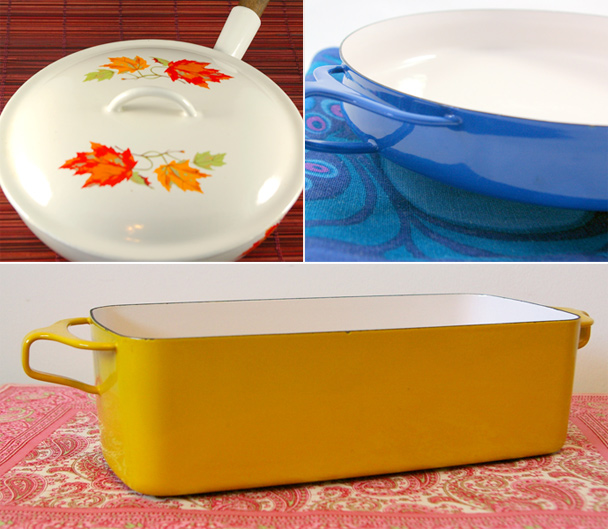Alison Walker is a medievalist by profession, so perhaps that historical mind-set explains why her coffeepot is a Chemex (continuously manufactured since 1941), her bread pan is a green enamel Copco (designed by Michael Lax in 1960), and she’s a little bit obsessed with vintage recipes. On Bit of Butter, the thrifting blog she writes with her husband, Kevin Eustice, she explains, “Part of the reason why I love vintage recipes, especially handwritten ones, is that they’re not as rigid as the recipes in today’s cookbooks. …Contemporary cookbooks…overexplain every slice and dice.”
So it stands to reason that one of Walker’s favorite uses for that Copco pan is banana bread, adapted from the 1962 Good Housekeeping Cookbook (and ideal to make ahead for breakfast on Black Friday). The pan’s heavy cast-iron core crisps the bread all over. The built-in cast-iron handles make it easy to pull out of the oven with pot holders. And the enamel—an attractive olive green—makes it pretty enough to plop down on the table. The same qualities apply to Walker’s midcentury butter warmer, an enameled metal pitcher with a long handle and pour spout that works just as well for stovetop gravy as it does for hot cocoa or melted butter. Why get out the silver when enamel looks just fine?
Copco is one of many brands popular in the United States in the 1950s and ’60s that featured bright colors, thoughtful design, and lots of specialized shapes. Originally manufactured in Europe, these lines were quickly adopted by American home cooks seeking to simplify their meals and minimize the dishwashing. The advent of pieces that married stylish form and function meant that casseroles, stews, sauces, and cakes no longer had to be transferred from pot to porcelain dish—the cookware and serveware were one. Dansk Kobenstyle, introduced in 1957, even includes pot lids that double as trivets for the buffet. Descoware, made in Belgium, was Julia Child’s pick: On her stove at the Smithsonian National Museum of American History sits a big orange pot she used on her pioneering television show. Other makers of the era, each with its partisans, include Dru Holland, French Cousances, original Le Creuset, and the less decorative, sturdier American-made Griswold.
Walker and Eustice are not alone in their obsession with vintage midcentury cookware (which they sell through their Etsy shop, also named Bit of Butter). Search these vintage brand names on Chowhound, and you’ll find a community engaged in equal parts nostalgia and design debate. The nostalgia is for food that people can’t imagine cooked in any other vessel. My grandmother, for example, always makes her perfectly cubed cheesy potatoes in a wide, round yellow Dansk buffet server. The potatoes turn out as golden as the dish, yet never browned. My Aunt Merit uses her orange Dansk rectangular dish for lasagna: The sides are higher than those of typical 9-by-13 pans, so there’s less chance of cheese bubbling over and burning. For Thanksgiving last year, I served sweet-and-spicy sweet potatoes in a red buffet server, a symphony of earth tones. Sunita Rai Khapre, who sells all types of vintage cookware on eBay at Asaaan Bazaar, swears that her Griswold Dutch oven turns ordinary stir-fried Indian cauliflower into something spectacular.
The design debate is multipronged. When my mother-in-law bequeathed quantities of flame-orange vintage Le Creuset to my sister-in-law, I didn’t mind, as I find Le Creuset too heavy for daily use. (If I can’t tilt the saucepan one-handed, I don’t want it.) Dansk Kobenstyle, by contrast, is made of enameled steel rather than cast iron, so the pieces are lightweight. According to design writer Sarah Froelich, whose 2010 MFA thesis is thought to be the first history of Dansk, that was precisely the point: Dansk founder Ted Nierenberg asked designer Jens Quistgaard to lighten up the traditional cast iron, thinking of the thin steel salad bowls then made by Krenit. The cross handles on Dansk’s lids are similarly pared down and elegantly curved.



 Pinterest
Pinterest


